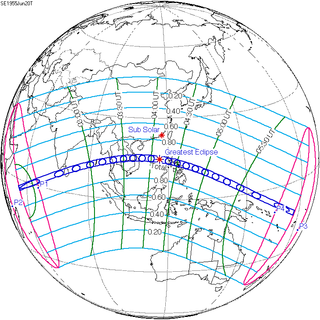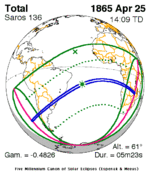Solar eclipse of June 20, 1955
| Solar eclipse of June 20, 1955 | |
|---|---|
 Map | |
| Type of eclipse | |
| Nature | Total |
| Gamma | -0.1528 |
| Magnitude | 1.0776 |
| Maximum eclipse | |
| Duration | 428 sec (7 m 8 s) |
| Coordinates | 14°48′N 117°00′E / 14.8°N 117°E |
| Max. width of band | 254 km (158 mi) |
| Times (UTC) | |
| Greatest eclipse | 4:10:42 |
| References | |
| Saros | 136 (34 of 71) |
| Catalog # (SE5000) | 9410 |
A total solar eclipse occurred on June 20, 1955. A solar eclipse occurs when the Moon passes between Earth and the Sun, thereby totally or partly obscuring the image of the Sun for a viewer on Earth. A total solar eclipse occurs when the Moon's apparent diameter is larger than the Sun's, blocking all direct sunlight, turning day into darkness. Totality occurs in a narrow path across Earth's surface, with the partial solar eclipse visible over a surrounding region thousands of kilometres wide. With a maximum duration of 7 minutes 7.74 seconds, this is the longest solar eclipse of saros series 136, as well as the longest total solar eclipse since the 11th century, and until the 22nd century, because greatest eclipse occurred near the Equator.[1] Totality beginning over the Indian Ocean, British Seychelles (today's Seychelles) and Maldives, crossing Ceylon (name changed to Sri Lanka later) including the capital city Colombo, Andaman Islands, Burma, Thailand including the capital city Bangkok, Cambodia, Laos, South Vietnam (now belonging to Vietnam), Paracel Islands and Scarborough Shoal (near the greatest eclipse), moving across the Philippines including the capital city Manila, Kayangel Atoll in the Trust Territory of the Pacific Islands (now belonging to Palau), Nukumanu Islands in the Territory of Papua New Guinea (today's Papua New Guinea), towards northern Ontong Java Atoll in British Solomon Islands (today's Solomon Islands) ending over Southwestern Pacific Ocean. It was the second central solar eclipse visible from Bangkok from 1948 to 1958, where it is rare for a large city to witness 4 central solar eclipses in just 9.945 years.
Related eclipses[]
Solar eclipses of 1953–1956[]
This eclipse is a member of a semester series. An eclipse in a semester series of solar eclipses repeats approximately every 177 days and 4 hours (a semester) at alternating nodes of the Moon's orbit.[2]
Note: Partial solar eclipse of February 14, 1953 and August 9, 1953 belong to the last lunar year set.
| Solar eclipse series sets from 1953–1956 | ||||
|---|---|---|---|---|
| Descending node | Ascending node | |||
| Saros | Map | Saros | Map | |
| 116 |  1953 July 11 Partial |
121 |  1954 January 5 Annular | |
| 126 |  1954 June 30 Total |
131 |  1954 December 25 Annular | |
| 136 |  1955 June 20 Total |
141 |  1955 December 14 Annular | |
| 146 |  1956 June 8 Total |
151 |  1956 December 2 Partial | |
Saros 136[]
Solar Saros 136, repeating every 18 years, 11 days, contains 71 events. The series started with partial solar eclipse on June 14, 1360, and reached a first annular eclipse on September 8, 1504. It was a hybrid event from November 22, 1612, through January 17, 1703, and total eclipses from January 27, 1721, through May 13, 2496. The series ends at member 71 as a partial eclipse on July 30, 2622, with the entire series lasting 1262 years. The longest eclipse occurred on June 20, 1955, with a maximum duration of totality at 7 minutes, 7.74 seconds. All eclipses in this series occurs at the Moon's descending node.[3]
| Series members 29–43 occur between 1865 and 2117 | ||
|---|---|---|
| 29 | 30 | 31 |
 Apr 25, 1865 |
 May 6, 1883 |
 May 18, 1901 |
| 32 | 33 | 34 |
 May 29, 1919 |
 Jun 8, 1937 |
 Jun 20, 1955 |
| 35 | 36 | 37 |
 Jun 30, 1973 |
 Jul 11, 1991 |
 Jul 22, 2009 |
| 38 | 39 | 40 |
 Aug 2, 2027 |
 Aug 12, 2045 |
 Aug 24, 2063 |
| 41 | 42 | 43 |
 Sep 3, 2081 |
 Sep 14, 2099 |
 Sep 26, 2117 |
Inex series[]
This eclipse is a part of the long period inex cycle, repeating at alternating nodes, every 358 synodic months (≈ 10,571.95 days, or 29 years minus 20 days). Their appearance and longitude are irregular due to a lack of synchronization with the anomalistic month (period of perigee). However, groupings of 3 inex cycles (≈ 87 years minus 2 months) comes close (≈ 1,151.02 anomalistic months), so eclipses are similar in these groupings.
| Inex series members between 1901 and 2100: | ||
|---|---|---|
 July 9, 1926 (Saros 135) |
 June 20, 1955 (Saros 136) |
 May 30, 1984 (Saros 137) |
 May 10, 2013 (Saros 138) |
 April 20, 2042 (Saros 139) |
 March 31, 2071 (Saros 140) |
 March 10, 2100 (Saros 141) |
||
Metonic series[]
The metonic series repeats eclipses every 19 years (6939.69 days), lasting about 5 cycles. Eclipses occur in nearly the same calendar date. In addition, the octon subseries repeats 1/5 of that or every 3.8 years (1387.94 days).
| 22 eclipse events, progressing from north to south between April 8, 1902 and August 31, 1989: | ||||
|---|---|---|---|---|
| April 7–8 | January 24–25 | November 12 | August 31-September 1 | June 19–20 |
| 108 | 114 | 116 | ||
 April 8, 1902 |
 August 31, 1913 |
 June 19, 1917 | ||
| 118 | 120 | 122 | 124 | 126 |
 April 8, 1921 |
 January 24, 1925 |
 November 12, 1928 |
 August 31, 1932 |
 June 19, 1936 |
| 128 | 130 | 132 | 134 | 136 |
 April 7, 1940 |
 January 25, 1944 |
 November 12, 1947 |
 September 1, 1951 |
 June 20, 1955 |
| 138 | 140 | 142 | 144 | 146 |
 April 8, 1959 |
 January 25, 1963 |
 November 12, 1966 |
 August 31, 1970 |
 June 20, 1974 |
| 148 | 150 | 152 | 154 | |
 April 7, 1978 |
 January 25, 1982 |
 November 12, 1985 |
 August 31, 1989 | |
Notes[]
- ^ Fred Espenak. "Catalog of Solar Eclipses: 1001 to 1100". NASA.
- ^ van Gent, R.H. "Solar- and Lunar-Eclipse Predictions from Antiquity to the Present". A Catalogue of Eclipse Cycles. Utrecht University. Retrieved 6 October 2018.
- ^ SEsaros136 at NASA.gov
References[]
- Total solar eclipses
- 1955 in science
- 20th-century solar eclipses
- June 1955 events



